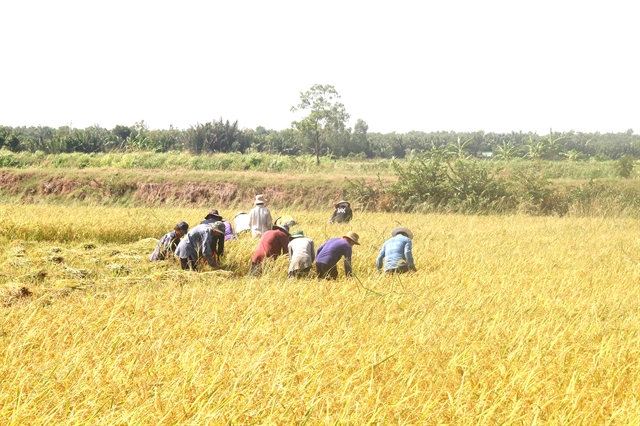
TIỀN GIANG – Farmers have managed to turn adversity into opportunity by adapting to salinity intrusion with a shrimp-rice farming model in the island district of Tân Phú Đông.
Located in the Mekong Delta Province of Tiền Giang, the island district is surrounded by the sea and the Cửa Tiểu and Cửa Đại estuaries.
The district is affected by saltwater intrusion for about six months in the dry season when it is not suitable for growing rice.
What farmers are doing in response is to breed shrimp during this period and cultivate rice in the rainy season.
So far, this model has proven effective, generating a stable income and helping many farmers escape poverty. With this mode, they can earn an average of VNĐ50 – 60 million (US$2,200 – 2,600) per hectare a year.
Lê Thanh Đằng, Deputy Chairman of the district’s People’s Committee, said that this model was adopted when implementing the province’s policy of restructuring agriculture production to cope with climate change.
Since then, the model is being applied on about 130ha, mostly in the district’s Phú Tân Comumme. The district now has the largest shrimp – rice farming area in the province, Đằng said.
Rice is usually grown between lunar June and October. Farmers in the district cultivate saltwater-resistant rice varieties like OM and VD20, which have high yield and high quality.
Ngô Văn Nhàn, one of the first farmers to implement shrimp-rice farming on his three-hectare field in Phú Tân, said under this model, shrimp is bred using the extensive farming method, which suits local farming skills of farmers and is easy to implement.
“The extensive farming method also has less risk compared to the intensive shrimp farming method and offers good returns,” he said.
The breeding period under the extensive farming method lasts about 5-6 months in the dry season and the rest of the time is spent on growing rice.
Favourable weather, plenty of fresh water resources and the application of advanced rice farming techniques delivered a bumper harvest the last crop, Nhàn said, adding that he earned a profit of VNĐ37 million ($1,600) per hectare.
Co-operative benefits
Locals have established the Phú Tân agriculture-fisheries co-operative group, which implements shrimp-farming on more than 60ha.
Hà Văn Hải, head of the co-operative group, said members have applied advanced farming techniques to produce clean rice and shrimp. They adhere to global good agricultural practices (GlobalGAP) standards, he said.
Its rice and shrimp have guaranteed outlets, he added.
While mitigating the impact of saltwater intrusion in the district’s coastal areas, the model has promoted sustainable farming and has proven a practical response to climate change, he said.
All members of the co-operative group now lead stable lives.
District authorities have promoted the model by providing the knowhow and advancing soft loans for farmers to implement the shrimp-rice farming model, helping many escape poverty.
Previously many farming areas had been left idle with farmers unable to grow crops because of saltwater intrusion. Instead they had to work as daily hired workers and lived in poverty. – VnExpress News
- Reduce Hair Loss with PURA D’OR Gold Label Shampoo
- Castor Oil Has Made a “Huge” Difference With Hair and Brow Growth
- Excessive hair loss in men: Signs of illness that cannot be subjective
- Dịch Vụ SEO Website ở Los Angeles, CA: đưa trang web doanh nghiệp bạn lên top Google
- Nails Salon Sierra Madre
 VnExpress News The News Gateway of Vietnam
VnExpress News The News Gateway of Vietnam





